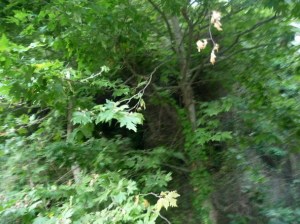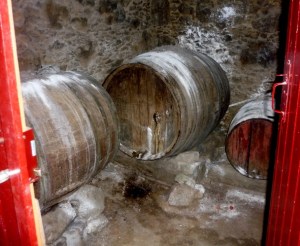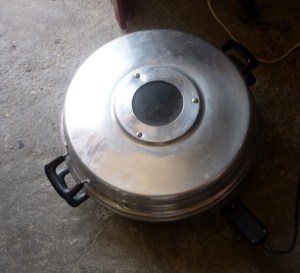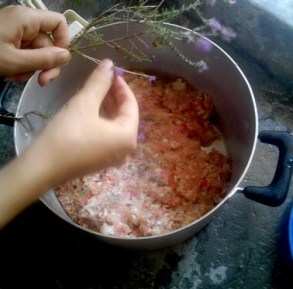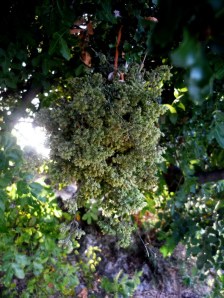1. I begin with two anecdotes.
a) When my friend Stavroula Markoulaki, archaeologist and president of the Historical, Folklore and Archaeological Society of Crete, ate a piece of fresh xinohondros during the Saturday branch of the 1 st Symposium of Greek Gastronomy she shook her head and said ” I feel such a fool”. Why? Because while living in the village Apothikes with her parents she never interested in her mother’s rich and complex knowledge of cooking and cheese making. “Now that I am interested in her rural cooking, she is dead and I don’t remember how to recreate her recipes. Oh my poor mom. I miss her so much!”
The cultural gap between rural mother and modern, educated daughter brought considerable changes in the transmission of traditional food. However, xinohontros evoked some of my friend’s deepest memories.
(Photo credit: Kyrstyn Kralovec)
Cretan xinohondros is a dried food based on a cooked mixture of fermented milk and cracked wheat. When it is still fresh and soft, xinohondros is a delicious creamy food.
b) Food has own stories to tell.
Katina Providaki and her tiganopites (Photo credit: Kyrstyn Kralovec)
During the preparation for the Symposium Saturday dinner, Katina Providaki, a volunteer local cook, suggested tentatively that she would like to make tiganopsomo (fried leavened flatbread). I was surprised when her 30 years old son said that his mother never makes it at home. “Why haven’t you ever made tiganopsomo for Stratis?” I asked her. “ This is a treasured delicacy from my childhood” she answered. ”My mother made use of the leftover bread dough; she hand flattened it after rising and fried it. While it was still warm she drizzled it with petimezi… you see, honey was very expensive but everybody had a little jar of petimezi. But after my mother passed away (she died when Katerina was 14 years old) I didn’t even try to make a tiganopsomo. My heart would break, I thought. Tomorrow, for the first time in my life, I will make tiganopsomo. Thus you will see how a poor mother “soothed her child’s insides” (malakone ta mesa tou paidiou tis)
For Katina tiganopsomo is the symbol of her mother’s love and care. And as Marcel Proust wrote in Remembrance of Things Past “…when from a long-distant past nothing subsists, after the people are dead, after the things are broken and scattered, taste and smell alone, more fragile but more enduring, more unsubstantial, more persistent, more faithful, remain poised a long time, like souls, remembering, waiting, hoping, amid the ruins of all the rest; and bear unflinchingly, in the tiny and almost impalpable drop of their essence, the vast structure of recollection” (Volume 1: Swann’s Way: Within a Budding Grove, translated by C.K. Scott Moncrieff and Terence Kilmartin p. 58).
Why does food hold such power?
2. Sadly, even in villages the knowledge of traditional foodstuffs is rapidly declining, while there is also a considerable loss of memory of poor people’s foods. Lantouridia is a typical dish of Crete’s “poor” cuisine. The most common way to prepare them is to combine flour or bread with water to form very small balls of dough. They are cooked in boiling water or milk or meat broth and they are served as a very thick soup. If they are boiled in water or milk they can be served with sugar or honey.
To make a pot of lantouridia for the Symposium Saturday dinner, the volunteer cook asked about 10 women. No one wanted to remember the exact method of preparation. (Who cares about those foods? They were poor, as poor as our houses. I don’t want to remember them… I don’t want to remember those days”: Stella Konstantoulaki).
I wonder how these foods are going to be archived for future generations.
3. Smelling a pot of basil or homemade stakovoutyro (butter) “It really smells like Chania!”
Stakovoutyro (Photo credit: Kyrstyn Kralovec)
In Greek, the experience of self -imposed exile, the absence from one’s home due to immigration is called “xenitia”. Xenitia conveys a condition of estrangement, hard living in foreign lands, long absence from homeland, though it can exploited to the benefit of the immigrant. It provokes an intense, deep pain of longing to return home (nostalgia).
The tastes and smells of homeland accompany xenitemenous (immigrants) in their new homes. The food recalls memories that include parents, relatives, friends, past events, homeland itself.
a) Xenitemenoi need to have some object as a tangible site for memory. Packages of food sent to migrants is a common link to home. Sometimes they are given the word “kaloudia” (goodies) and they carry inside them the sun of the homeland, its sea, the smells of family house, the mother’s love. They are a piece of patrida (homeland).
b)Xenitemenoi live with a foot in both worlds. For them, the role of food and memory in preserving their identity is as essential as the language and news from home. Thus, food not only express the sense of loss and desire for home but also signifies a sense of belonging. Two Symposium speakers,Maria Verivaki and Ozlem Yasayanlar , referred to this wonderful part of culture, the food memories and identity. Please click here to read the abstracts of their announcements: http://greekgastronomy.wordpress.com/abstracts/
And click here to read a great article about xenos (foreigner), xenia (hospitality) xenitia and xenophobia http://diatribe-column.blogspot.com/2007/10/xenia.html
As you have probably already guessed, the theme for the 2013 Symposium will focus on Food, Memory and Identity.
ΓΙΑ ΕΛΛΗΝΙΚΑ ΕΔΩ








